Basic AI Chatbot Pricing: A simple chatbot that can answer questions about a product or service might cost around $10,000 to develop.
Read More

Ever had that moment when a brand’s AI assistant greets you by name, solves your problem in under 10 seconds, and leaves you wondering… “Wait, why don’t we have one of these?”
Meanwhile, your team is buried under emails, your customers are stuck on hold, and somewhere in the distance, your competitor is quietly stealing your market share.
We aren’t kidding. The AI virtual assistant market is expected to explode from $10.4 billion in 2024 to $154.8 billion by 2034, growing at a blistering 31% CAGR (Market.us).
That’s not a trend. That’s the kind of shift that separates tomorrow’s industry leaders from the companies people barely remember.
This is your chance to develop AI virtual assistant technology that does more than just respond to questions.
We’re talking about assistants that upsell without sounding pushy, remember your customers better than their in-laws, and work tirelessly without ever asking for vacation.
Whether your goal is to build AI virtual assistant for smarter customer support or create AI virtual assistant to supercharge sales, the playbook is here.
In this guide, we’ll show you how to make an AI virtual assistant that actually delivers ROI, walk you through the steps from scratch, and give you implementation tips that work in the real world.
So grab your coffee as we’re about to explore why building your own assistant isn’t just smart, it’s survival.
If business was a race, AI virtual assistants are the jet engines, and right now, your competitors are already strapping them on.
Every month you wait to develop AI virtual assistant, you’re leaving room for someone else to answer your customers faster, sell to them smarter, and remember them better than you do.
That’s like spotting your rival a five-lap head start.
Sticking to traditional customer service and operations feels safe… until it starts costing you money.
Without the right build AI virtual assistant strategy, you’re dealing with:
Every one of these is a slow leak in your growth bucket.
And left unchecked, leaks turn into floods.
Now, let’s talk about what happens when you decide to create AI virtual assistant for your business today:
In a world where speed and personalization win, an AI assistant is your frontline, your brand voice, and your sales ally rolled into one.
And here’s the fun part, the tech to make an AI virtual assistant that’s smart, friendly, and revenue-focused is no longer reserved for tech giants.
Which brings us to the next big question: what kind of assistant should you build?
If you’re curious about the practical process, here’s a detailed guide on how to create your own AI business assistant.

AI assistants come in more flavors than your favorite ice cream shop, and each type has its own personality and purpose. When you build AI virtual assistant, knowing which type fits your business is half the battle.
Think of them as your friendly front-desk clerk who never sleeps.
They live on websites, apps, and messengers, answering FAQs, scheduling appointments, and nudging leads further down the funnel.
Simple, effective, and perfect for businesses that want to develop AI assistant for business without breaking the bank.
Ever wished your brand had its own Siri or Alexa? That’s exactly what voice assistants deliver.
Hands-free, conversational, and ideal for customer support hotlines or smart devices.
If your audience loves talking more than typing, this is the assistant to create AI virtual assistant that feels natural. Businesses exploring this route often look into how to build AI chatbot voice assistants for customer engagement.
These aren’t just assistants, they’re brand ambassadors with faces.
AI avatars can present, guide, or even onboard customers in a visually interactive way. They’re making waves in retail, training, and even healthcare.
Imagine a virtual rep that remembers your customers’ favorite products and greets them with a smile. Businesses and individuals alike are exploring how to create a personal AI assistant to offer this level of customized interaction.
Hyper-focused on a niche, these assistants know your business inside out.
From healthcare symptom triage bots to e-commerce product recommenders, they don’t just chat, they solve.
If you want to make an AI virtual assistant that feels like a seasoned industry pro, this is your lane.
The newest kid on the block.
These assistants don’t just respond, they act. They can proactively schedule meetings, trigger workflows, or escalate issues before you even know they exist.
Building one means stepping into the future of automation, where your assistant is less “chatbot” and more “digital colleague.”
Agentic assistants are gaining traction as businesses learn how to build agentic AI that goes beyond reactive responses and takes proactive action.
These assistants combine text, voice, and even image recognition in one smooth experience.
They’re built for users who expect flexibility and richer interactions.
Want to ask a question, upload a photo, and get an instant spoken answer? This is where multimodal assistants shine.
These are designed to boost workplace productivity by automating internal workflows, knowledge retrieval, and team collaboration.
They don’t just serve customers, they serve your employees too.
Also read: How to Develop AI Productivity Assistant App
Whatever flavor you choose, the type of assistant you build sets the tone for customer experience.
Whether it’s a chatbot, voice bot, or digital colleague, we’ll help you choose right.
Contact NowKnowing the types is only step one. The real magic is seeing how they transform entire industries. And that’s exactly what we’ll cover next, use cases to build AI virtual assistant across industries.
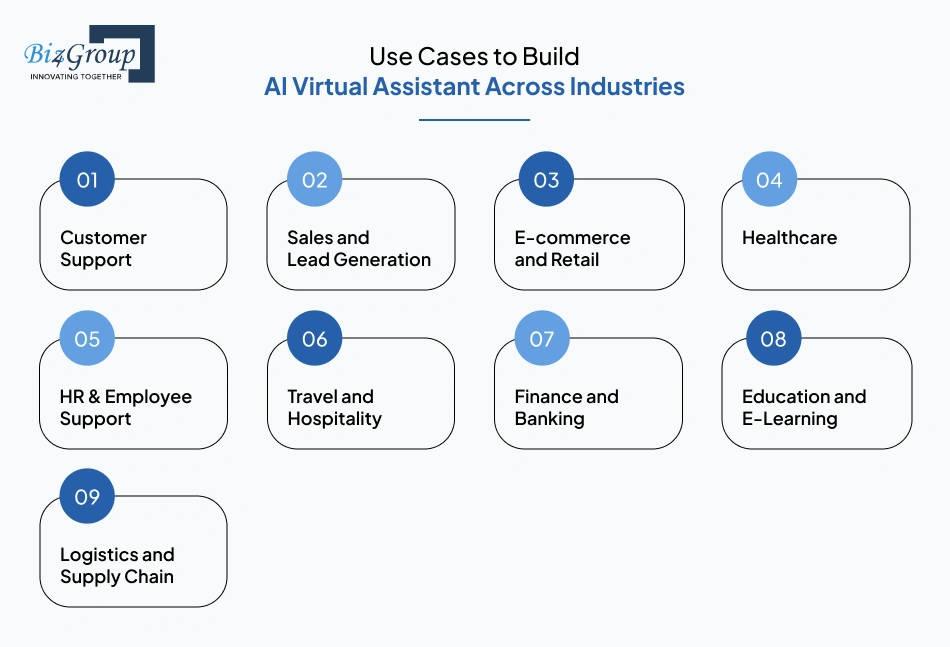
When you build AI virtual assistant, the possibilities go far beyond answering simple customer queries.
Different industries are tapping into AI assistants to cut costs, improve engagement, and scale operations without adding headcount.
Here’s where enterprise AI solutions can unlock real impact across industries:
Customer service is where AI assistants shine the brightest.
By automating routine interactions, businesses can offer round-the-clock support while reserving human agents for complex issues.
An assistant doesn’t just answer questions, it sells.
Virtual assistants qualify leads, book appointments, and nurture prospects until they’re sales-ready.
Shoppers want speed, personalization, and convenience.
An AI assistant can be the digital shopping buddy who never gets tired.
Also read: How to Build AI Fashion Assistant App
Virtual assistants are making healthcare more efficient and accessible by handling tasks that free up doctors and staff.
Similarly, in the legal sector, an AI legal assistant can simplify case research, contract analysis, and client queries, reducing the burden on attorneys.
Internal assistants save time and headaches for HR and IT teams while giving employees quick access to what they need.
From flight bookings to concierge services, AI assistants help travelers move smoothly from point A to point B.
Similarly, real estate is another industry where AI is creating massive efficiency gains. An AI real estate assistant can simplify property searches, answer buyer inquiries instantly, and guide prospects through the mortgage or rental process.
Money matters require speed and accuracy, and virtual assistants are transforming the way customers interact with financial services.
Many organizations are adopting AI financial assistant apps to deliver secure, personalized support at scale.
AI assistants are showing up in classrooms and online platforms, making learning more interactive and accessible.
Also read: How to Build an AI Teaching Assistant
Managing shipments, deliveries, and inventories is no easy feat.
AI assistants bring visibility and efficiency to the mix.
AI assistants are becoming industry essentials. Whether it’s guiding a customer through checkout or helping an employee onboard faster, the use cases are multiplying.
So now that you know where AI assistants can work wonders, let’s break down what makes them tick.
Every great assistant (human or AI) is only as good as the skills it brings to the table.
When you create AI virtual assistant, you can’t just throw in a chatbox and call it a day. The secret is equipping it with the right blend of intelligence, integration, and personality.
Here are the core features your AI assistant needs to shine:
| Feature | Why It Matters | How It Works in Action |
|---|---|---|
|
Natural Language Processing (NLP) & NLU |
Enables the assistant to understand intent and context beyond keywords |
Detects if “cancel my order” means a refund request or stopping a subscription |
|
Multi-Channel Support |
Customers don’t stick to one platform, neither should your assistant |
Works across web chat, social media DMs, email, and even WhatsApp |
|
Personalization |
Builds loyalty by remembering preferences and history |
Suggests a product based on past purchases or recalls previous issues |
|
Integration with Business Systems |
Keeps workflows smooth by connecting to CRMs, ERPs, and ticketing tools |
Pulls order details from Salesforce or updates a case in Zendesk |
|
Analytics & Reporting Dashboard |
Shows performance metrics and customer insights |
Tracks resolution time, customer satisfaction, and conversation trends |
|
Scalability |
Grows with your business needs without crashing under load |
Handles 50 queries a day now or 5,000 during a holiday rush |
|
Multilingual Capabilities |
Expands your reach to global audiences |
Chats fluently in English, Spanish, French, and beyond |
|
Security & Authentication |
Builds trust and protects sensitive data |
Uses encrypted channels and role-based access controls |
These are the “non-negotiables” in AI virtual assistant development.
Skip one, and you risk frustrating your users, overloading your team, or missing out on valuable data.
From NLP to security, our team has you covered. Start building today.
Schedule a Free CallNow, if you really want to make an AI virtual assistant with natural language processing that turns heads, the essentials alone won’t cut it. That’s where advanced features come in, the kind that move your assistant from “helpful” to “unforgettable.”
Sure, the basics get the job done. But if you really want your assistant to feel less like a scripted bot and more like a sharp digital colleague, you’ll need to add some advanced flair.
Here’s where the magic happens when you make an AI virtual assistant with natural language processing that’s built for the future.
No one likes a robot that sounds… well, robotic.
Emotional intelligence lets your assistant detect tone, sentiment, and urgency in a user’s message.
Whether the customer is angry, confused, or delighted, the assistant adjusts its tone and responses accordingly.
It’s empathy, scaled by code.
Traditional assistants wait for instructions. Agentic ones take initiative, especially when designed with the expertise of an AI agent development company.
Imagine an AI assistant that notices a recurring delivery issue, escalates it to logistics, and emails affected customers before complaints even roll in.
That’s not customer service, that’s customer delight.
Ever had to re-explain your problem to three different agents? Painful.
Assistants with memory retain context from previous interactions, personal preferences, and even quirks.
It’s like talking to someone who actually listens… every single time.
Why limit interactions to just text or voice? Multimodal assistants can process text, voice, and even images together.
Upload a picture of a broken product, explain the issue, and your assistant can recognize it, suggest solutions, or trigger a replacement order.
The smartest assistants don’t just “perform”, they improve.
By analyzing past conversations, they refine their responses, reduce errors, and adapt to new user behaviors.
Think of it as self-upgrading software, minus the annoying version updates.
Instead of waiting for you to ask, the assistant anticipates your needs.
It reminds you to reorder before you run out, nudges you about an upcoming bill, or suggests a new feature based on your recent queries.
Suddenly, your assistant isn’t just helpful, it’s indispensable.
Advanced features are what transform a virtual assistant from a digital receptionist into a true business asset. They create experiences that feel human, scalable, and even a little magical.
Now that we know what your assistant can do, the real question is, how do you actually build it?
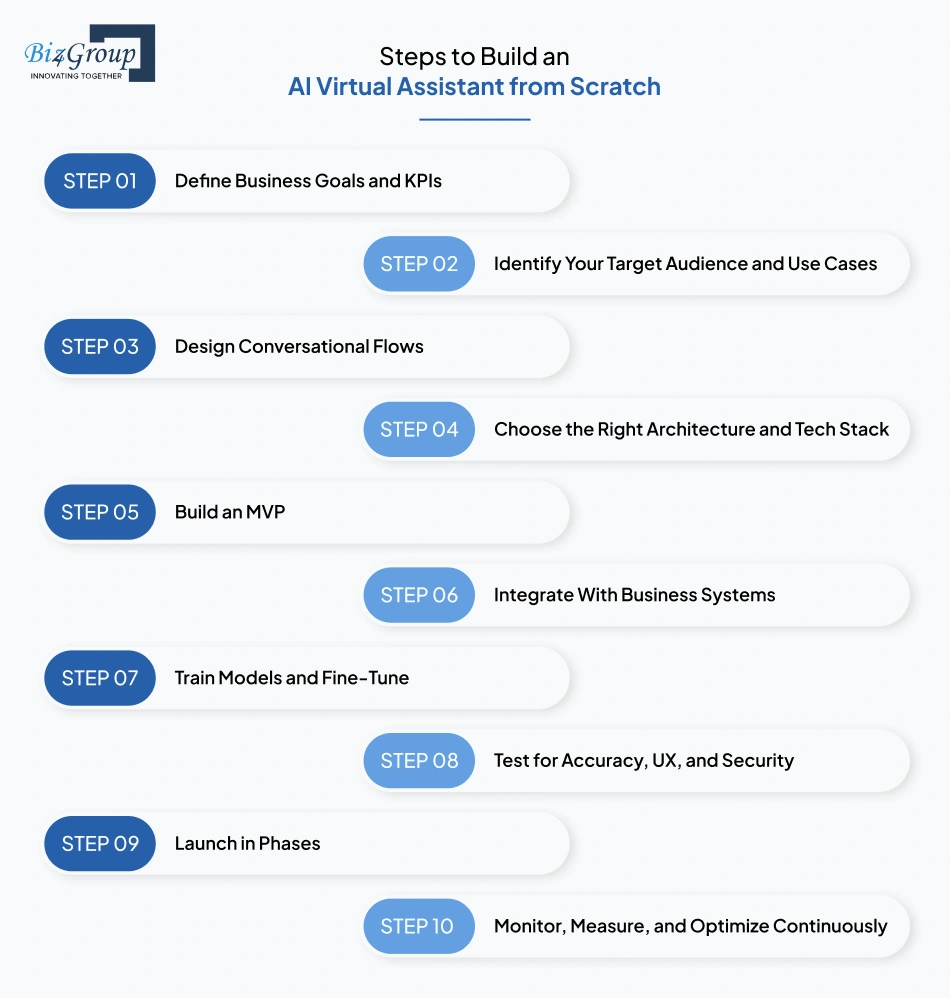
So, you’ve picked your type, you’ve got your wish list of features, and you’re ready to develop AI virtual assistant that works harder than your best employee. But where do you even begin?
Building an assistant isn’t just about throwing machine learning into a chatbot framework. It’s a structured journey.
Here’s your roadmap, complete with checkpoints to keep you on track.
Every great build starts with clarity. Decide why you’re doing this.
Is it to slash support costs, boost sales, or improve customer experience?
Without goals, you’ll end up with a glorified toy.
Your assistant isn’t for “everyone”, it’s for your customers, employees, or both.
Tailor it to their needs.
This is where your assistant gets its personality.
Good flow design makes interactions seamless, not stiff.
No architecture, no assistant.
This is the engine under the hood.
Don’t aim for perfection on day one.
Build a lean prototype that solves one clear problem well, ideally with expert MVP development services to validate your idea quickly and cost-effectively.
Also read: Top 12+ MVP development companies in USA
Your AI assistant can’t operate in a silo.
Connect it with your existing tools through expert AI integration services that ensure smooth workflows.
This is where machine learning in AI virtual assistant creation really kicks in.
Don’t let customers be your beta testers.
Stress-test your assistant before launch.
Rolling out your assistant all at once is like throwing a toddler into a marathon.
Go step by step.
Building is only half the job.
Optimization is forever.
The process may look linear, but in practice, it’s a cycle... define, build, test, learn, optimize, repeat.
That’s how you build custom AI virtual assistant that grows smarter with time, not stale.
Don’t just read the roadmap, let’s walk it together and build your AI.
Build with UsNext, we’ll peel back the curtain on the tech stack for AI virtual assistant development, so you know which tools and frameworks can power your assistant from the ground up.
When you develop AI virtual assistant, think of the stack as your assistant’s skeleton and nervous system.
From the sleek interface your customers see (frontend), to the backend engines, to the AI brain, every layer matters.
Below are the building blocks, neatly stacked in tables for easy comparison.
| Purpose | Options | Best For | Notes |
|---|---|---|---|
|
Web UI |
React, Angular, Vue.js |
Rich browser-based assistants |
Supports custom widgets, chat windows, dashboards |
|
Mobile UI |
Flutter, React Native, Swift (iOS), Kotlin (Android) |
Cross-platform mobile apps |
Native SDKs for messaging and speech |
|
Chat Widgets |
Botpress UI Kit, Kommunicate, LivePerson SDK |
Drop-in web chat interfaces |
Quicker deployment without custom dev |
A polished frontend ensures your assistant isn’t just smart, but also a pleasure to interact with. Partnering with an experienced UI/UX design company can help create interfaces that feel seamless and user-friendly.
Also read: Top 15 UI/UX Design Companies in USA
| Purpose | Options | Best For | Notes |
|---|---|---|---|
|
Core backend frameworks |
Node.js, Python FastAPI, Django, Java Spring Boot |
Handling API requests, routing, orchestration |
|
|
API architecture |
REST, GraphQL, gRPC |
Communication between assistant and services |
GraphQL flexible for multi-channel queries |
|
Middleware |
Express.js, NestJS, Flask |
Business logic layer |
Ideal for integrating workflows and APIs |
Backend is the control room. Without it, your AI’s brain doesn’t connect to the outside world.
| Purpose | Options | Best For | Notes |
|---|---|---|---|
|
Foundational LLMs |
OpenAI, Anthropic, Google, Meta Llama |
Broad language tasks |
Fast to start, strong tooling |
|
Open source models |
Llama, Mistral, Falcon |
Customization, on-prem |
Control privacy and tuning |
|
Multimodal |
GPT-4o, Gemini, Llava |
Text + image/voice tasks |
Customer support, product troubleshooting |
| Purpose | Options | Best For | Notes |
|---|---|---|---|
|
Tokenization, parsing |
spaCy, NLTK |
Traditional NLP tasks |
Works well alongside LLMs |
|
Embeddings |
OpenAI, Cohere, Sentence Transformers |
Semantic search & RAG |
Key for contextual answers |
|
Speech to text |
Whisper, Azure STT, Google STT |
Voice assistants |
Choose based on accent/noise accuracy |
|
Text to speech |
ElevenLabs, Amazon Polly, Azure TTS |
Natural voice output |
Adds personality to voice bots |
| Purpose | Options | Best For | Notes |
|---|---|---|---|
|
Flow management |
Rasa, Dialogflow CX, Microsoft Bot Framework |
Structured conversations |
Hybrid rule + LLM setups |
|
Agent frameworks |
LangChain, LangGraph, Semantic Kernel |
Complex tool use and planning |
Add guardrails for reliability |
|
Retrieval pipelines |
LlamaIndex, Haystack |
Knowledge base querying |
Connects to docs, CRMs, intranets |
| Purpose | Options | Best For | Notes |
|---|---|---|---|
|
Vector DBs |
Pinecone, Weaviate, FAISS, pgvector |
Context recall, RAG |
Crucial for personalization |
|
Operational DBs |
PostgreSQL, MySQL, MongoDB |
Sessions, user profiles |
Encrypt sensitive fields |
|
Caching |
Redis |
Speeding up responses |
Useful for high-volume chats |
| Purpose | Options | Best For | Notes |
|---|---|---|---|
|
Business apps |
Salesforce, HubSpot, Zendesk, ServiceNow |
CRM, ERP, ITSM |
Drives productivity |
|
Messaging channels |
Slack, WhatsApp, Teams, Messenger, Web Chat |
Omnichannel presence |
Meet users where they are |
|
API glue |
Node.js, FastAPI, GraphQL |
Service orchestration |
Contracts keep integrations reliable |
| Purpose | Options | Best For | Notes |
|---|---|---|---|
|
Cloud |
AWS, Azure, GCP |
Managed AI + infra |
Check compliance & regions |
|
Containers |
Docker, Kubernetes |
Scaling workloads |
Autoscaling for demand spikes |
|
Serverless |
AWS Lambda, Cloud Functions |
Lightweight tasks |
Great for event-driven ops |
Quick Recap:
Frontend is the face. Backend is the backbone. AI frameworks are the brain. Data layers are the memory. Cloud and MLOps are the gym membership keeping everything in shape.
Get these aligned, and you’ll create AI virtual assistant that’s powerful, scalable, and user-friendly.
Next stop: let’s talk about something that can make or break adoption.
If you’re going to develop AI virtual assistant for your business, here’s the hard truth: customers will trust it only as much as they trust you with their data.
One breach, one compliance slip, and all the “smart conversations” in the world won’t save you.
Security and compliance aren’t afterthoughts; they’re the guardrails that keep your AI assistant from becoming a liability.
Building trust isn’t about flashy features, it’s about securing every byte of data and complying with the rules that protect your customers.
Nail this part, and you don’t just build custom AI virtual assistant, you build loyalty.
Let’s get tactical now and talk about implementation tips, the hands-on strategies that turn your AI project from theory into a working, business-ready assistant.
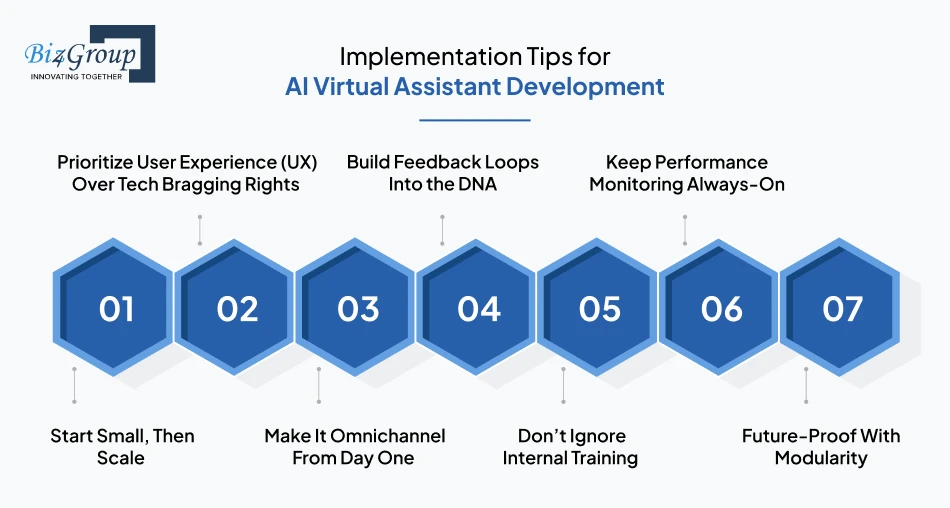
So you’ve got the tech stack, the compliance guardrails, and a shiny roadmap.
Now comes the tricky part: actually putting it all together without creating a clunky chatbot that frustrates more than it helps.
Implementation is where the “how” meets the “wow.”
Here’s how to keep your AI virtual assistant implementation smooth, scalable, and downright impressive.
Think MVP, but for virtual assistants.
Implementation isn’t a one-time project, it’s an ongoing strategy.
The companies that succeed are the ones treating their AI assistant as a living, evolving product, not a side experiment.
Get this right, and you’re not just going to create AI virtual assistant to improve customer experience, you’ll make it a growth engine.
The right strategy makes the difference between “meh” and “wow.”
Talk to Our ExpertsNext up are the roadblocks, the real-world challenges businesses face while building assistants, and how to crush them before they crush you.
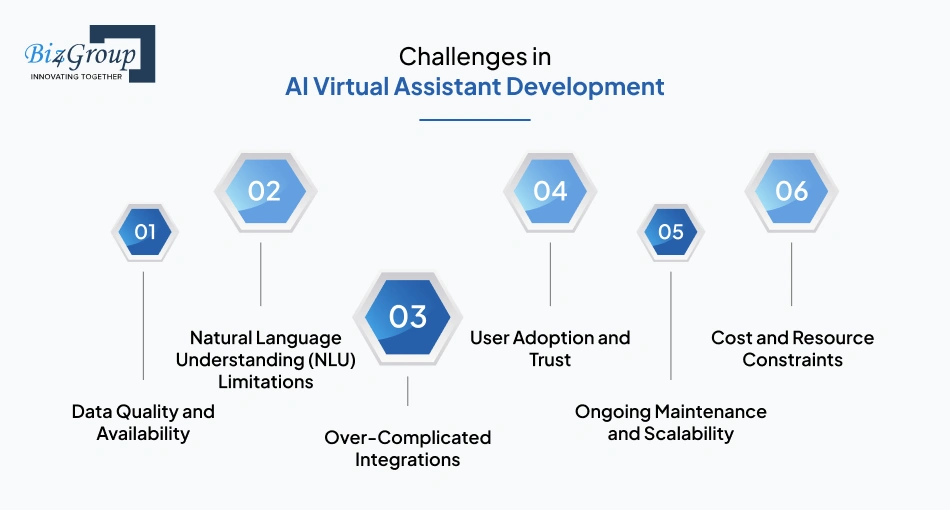
Building a virtual assistant sounds futuristic, but the road is paved with potholes.
Every business hits snags, from messy data to unrealistic expectations, that can derail the intelligent virtual assistant building process.
The good news? Most of these challenges have clear solutions.
Let’s break them down.
AI assistants live and die by data.
Without enough training data, or worse, with messy, biased, or inconsistent data, your assistant will stumble over even simple queries.
Solution:
Customers don’t always type perfectly. They use slang, abbreviations, or even sarcasm.
A poorly tuned assistant will misunderstand and frustrate users.
Solution:
Your assistant may need to talk to CRMs, ERPs, payment gateways, or ticketing systems.
Each integration can become a technical nightmare if not planned well.
Solution:
Even the smartest assistant will flop if users don’t trust it or see its value.
Resistance from employees or skepticism from customers is common.
Solution:
Businesses often underestimate the upkeep.
Models drift, integrations break, and user needs evolve, leaving the assistant outdated.
Solution:
Especially for small businesses, budgets are tight and skilled AI engineers are expensive.
The project risks stalling halfway.
Solution:
Challenges in AI virtual assistant development are more like speed bumps. With the right strategy, you can glide over them and stay on track.
And once you do, you’re ready to look beyond today’s assistant and into the future trends shaping how businesses will interact with customers tomorrow.
Choosing the right development partner is just as important as choosing the right technology.
At Biz4Group, we don’t just “build software” we act as your trusted advisors, helping you transform ambitious ideas into real-world, market-ready solutions.
Headquartered in the US, we specialize in end-to-end software development for entrepreneurs, startups, and enterprises, with a focus on emerging technologies like AI, IoT, and Cloud.
As a leading AI app development company, we bring both technical depth and industry expertise. Our approach is simple: blend cutting-edge engineering with business-first thinking.
That’s how we’ve helped visionaries turn napkin sketches into multi-million-dollar platforms, without losing sight of scalability, security, and speed-to-market.
Business-Driven Tech Mindset
When partnering with us, you don’t just hire AI developers who code.
Every solution is designed to meet business KPIs and customer needs.
From conversational AI to IoT ecosystems, our portfolio shows we know how to navigate complex technologies.
Flexible enough to adapt to market shifts, yet structured to ensure on-time, on-budget delivery.
Clear communication, milestone-based delivery, and no surprises.
We innovate without over-engineering, ensuring solutions are both future-proof and cost-effective.
Need proof? Here you go...
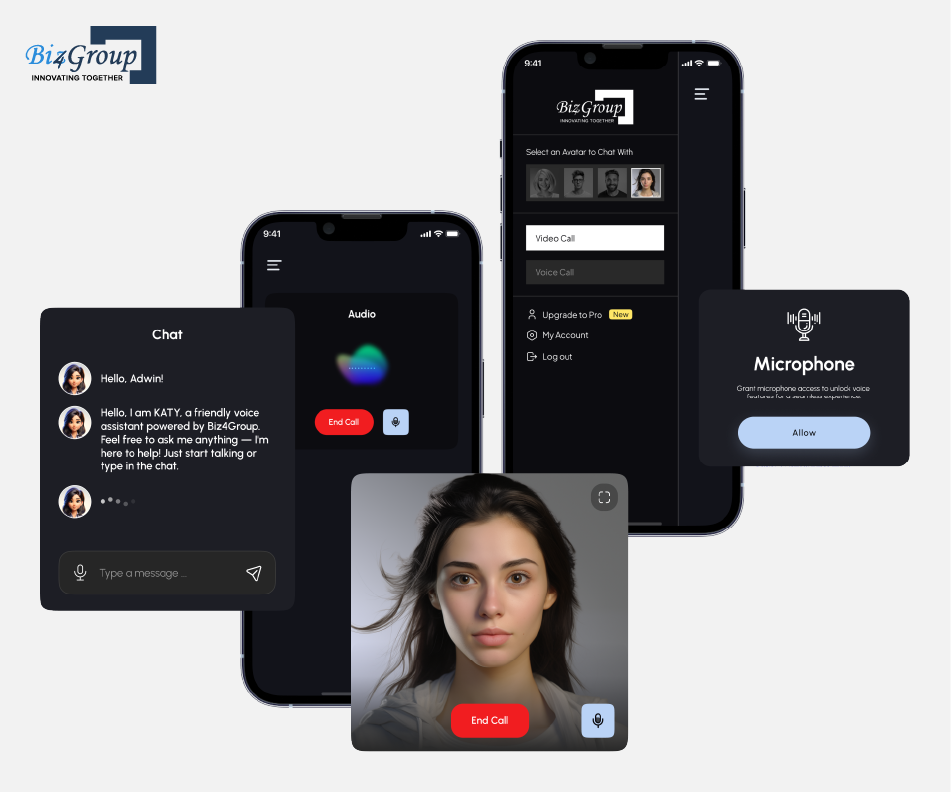
One of our proudest innovations is AI Wizard, an avatar-based AI companion that redefines digital interactions.
Designed to act like your go-to friend in times of need, AI Wizard merges fun, utility, and companionship in one platform.
What makes it special?
Challenges We Solved Along the Way:
In short, AI Wizard proves what happens when vision, expertise, and execution meet, a hallmark of Biz4Group’s approach to every project.
The AI space is crowded, but not all AI solutions are created equal.
What sets us apart isn’t just our technical prowess, it’s the way we align technology with your vision and market opportunity.
If you’re ready to build custom AI virtual assistants that deliver real business impact, Biz4Group is the partner to make it happen.
Ready to see what your AI assistant could look like? Let’s talk.
The truth is, building an AI virtual assistant isn’t just about chasing trends, it’s about creating real business value. From automating customer support to personalizing user experiences, an intelligent assistant can become the hardest-working member of your team (and it won’t even ask for coffee breaks).
But here’s the catch: the difference between a clunky chatbot and a seamless AI assistant lies in the strategy, execution, and experience of the team behind it.
That’s where Biz4Group steps in.
With years of expertise in AI virtual assistant development and a track record of building scalable, business-focused solutions, we help companies move beyond ideas to results that matter.
So, if you’ve been wondering how to develop an AI virtual assistant that not only works but wows, the next move is yours.
Let’s build something intelligent together.
The timeline depends on the complexity and features you choose. A basic AI assistant with simple Q&A may take 2–3 months, while a custom solution with advanced NLP, integrations, and personalization can extend to 6–9 months. The more complex the workflows and integrations, the longer the development cycle.
While customer service and e-commerce are the most obvious beneficiaries, industries like healthcare, real estate, banking, logistics, and even education are adopting AI assistants to improve efficiency and engagement. Any business that relies on repetitive queries or process automation can gain immediate value.
Yes. Modern AI assistants are built to integrate with CRMs, ERPs, marketing platforms, and even internal communication tools like Slack or Teams. Seamless integration ensures the assistant doesn’t just answer questions but actually drives workflows and business processes.
Costs vary widely depending on complexity, tech stack, and level of customization. A simple AI chatbot might start from a few thousand dollars, while enterprise-grade assistants with advanced machine learning, analytics, and multi-platform support can run into six figures. Check out our development cost blog for more details.
Key risks include data privacy concerns, poor user adoption, limited accuracy in responses, and integration challenges. However, these risks can be minimized with proper planning, choosing the right tech stack, and following best practices for compliance and security.
Not at all. AI assistants are designed to complement human teams by handling repetitive, low-value tasks, freeing employees to focus on strategic and creative work. Think of them as a digital ally, not a replacement.
with Biz4Group today!
Our website require some cookies to function properly. Read our privacy policy to know more.